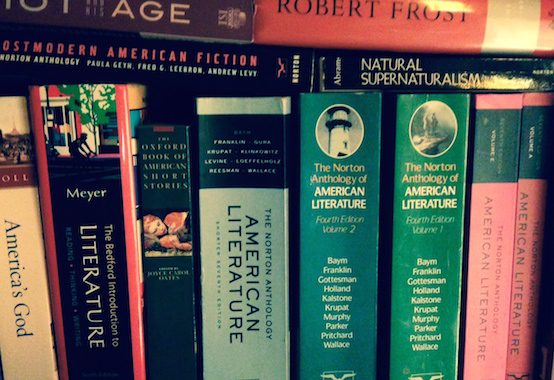Against the Anthology

The first Norton Anthology of American Literature was published 35 years ago this year. According to its editors at the time, it set itself the laudable goal of redressing “the long neglect of women writers” and doing “justice to the contributions of black writers to American literature.” To that end, it printed selections from the work of 29 women and 14 African-Americans, many of whom had never been included in an anthology of American literature.
The selections were viewed by some as insufficient, but it was a significant improvement on previous anthologies. The 1938 Oxford Anthology of American Literature printed the work of 12 women, but the 1952 edition of the popular Major American Writers included selections from only Emily Dickinson and the novelist Ellen Glasgow.
In subsequent editions, the Norton did further “redressing,” adding the work of Lorine Niedecker, Claude McKay, Michael S. Harper, and many other accomplished writers. But even a cursory examination of the most recent edition shows that something has also gone wrong.
At five volumes and nearly 6000 pages, the latest edition of the Norton, published in 2011, is almost twice as long as the 1979 edition. Despite this, selections from what the first edition called the “traditional masterpieces of American literature” have been greatly reduced. Walt Whitman has gone from around 70 to 30 poems. Henry David Thoreau has gone from over 200 pages to a little over 100. Herman Melville has lost nearly 100 pages, and Edgar Allen Poe has gone from 150 to 100 pages. Perhaps unsurprisingly, selections of William Cullen Bryant and Henry Wadsworth Longfellow have been cut in half, and William Bartram, Oliver Wendell Holmes, James Russell Lowell, Archibald MacLeish, Allen Tate, and others have disappeared entirely.
Some of the extra space is used for previously neglected writers, but a fair amount is also used for speeches and essays on topics such as the plight of Native Americans, slavery and civil rights, women’s suffrage, American Exceptionalism, World War I, and terrorism. To give one example, there are roughly 230 pages in the latest Norton of non-literary texts (speeches, political essays, and autobiographies) related to the customs and life of Native Americans. This is only slightly fewer than the pages devoted to Edgar Allen Poe, Walt Whitman and Emily Dickinson combined.
Context is important in the study of literature, and many of the historical texts included in the Norton are interesting, but they can also bury the literature. Each of the five volumes in the 2011 Norton contains at least one special section on a political topic. In the accompanying teacher’s guide, while a mere five pages are devoted to using the anthology to teach “Major American Authors,” there are two chapters and over 30 pages on how to engage the issues of gender, race, war, and identity explored in the anthology. There is nothing on beauty, truth, or the pleasure of reading.
Other anthologies have followed suit over the years. While Longman’s two-volume anthology is less enamored with politics than the Norton, it nevertheless sells itself for its “contextual selections.” The Bedford too is committed to helping “students grasp the cultural, material, and social conditions in which literary works are produced.”
One of the great pleasures of reading the work of a particular period is experiencing how messy and diverse it is. In the 1950s, for example, T.S. Eliot was publishing his later plays, Allen Ginsberg was howling in California, Ralph Ellison won the National Book Award, Gwendolyn Brooks won the Pulitzer Prize for Poetry, Walker Percy was writing essays for America and Commonweal, J.F. Powers was publishing stories in The New Yorker, Kurt Vonnegut was writing for Collier’s, Robert Frost published Hard Not To Be King, and John Ashbery won the Yale Younger Poets Prize.
This sort of messiness goes unhighlighted in the Norton and many other anthologies. Neither Walker Percy nor J.F. Powers are included in the work, and the others are separated by an entire volume and special sections on modernism and postmodernism. While tacitly committed to diversity, the Norton offers a superficial and perhaps even irrelevant kind when it comes to literature—one determined by gender, race, and the increasingly narrow research interests of English professors more so than by style or ideas. As with all anthologies, the selections in the most recent Norton are also too excerpted or too small to give readers an overarching sense of the work of all but a few writers, much less how they might differ from others.
In 1979, the Norton editors hoped to create “a book to be read for pleasure.” Today, it is a book read for credit. It presents literature as secondary to history and as something to be sifted for proof of political theories rather than appreciated. No wonder most students leave it and the reading of great works behind when they graduate.
While the problems of college English are many and complex, getting rid of the contemporary anthology might be one way of reintroducing some life in the classroom. It might also show students how valuable and relevant great literature can be on its own.
Comments